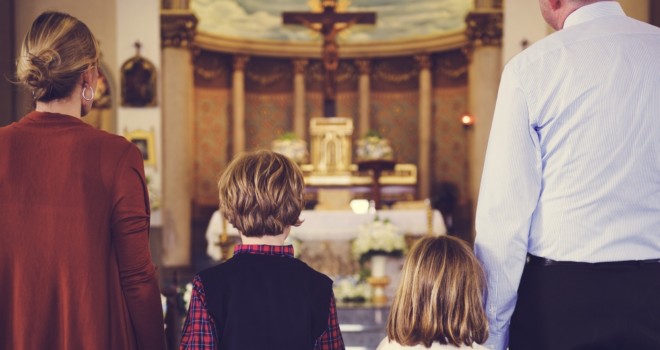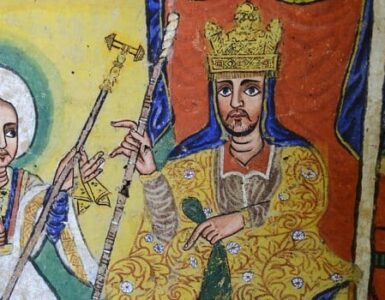Lent is primarily known as a time devoted to fast and abstinence. Our non-Catholic friends feel sorry for us because we have to watch our food. “Isn’t it an awful strain?”
But this is only one side of the season of Lent, and not even the most important one. First and foremost, these weeks between Ash Wednesday and Holy Saturday are set aside as a time of preparation for the greatest feast of the year, Easter.
We are not fasting in commemoration of Our Lord’s fast of 40 days but are imitating Him in His fast of preparation — preparation for His great work of Redemption. It is the same with us. Once a year, we take 40 days out of the 365, and we too fast in preparation: in preparation for the commemoration of our Redemption.
We all should get together and work toward the restoration of the meaning of Lent. People nowadays see in it just a gloomy time full of “must nots.” That is a great pity, because Lent is a solemn season rich in hidden mysteries. We must also keep in mind that Lent is only a part of the great Easter season, that it is for Easter what Advent was for Christmas, and that Lent taken by itself would make no more sense than Advent without Christmas at its end. Therefore, we should let Holy Mother Church take us by the hand and lead us — not each soul alone, but the whole family as a group — away from the noise of the world into a forty-day retreat.
No other time of the year has been so singled out by the Church as this, in that a completely different Mass is provided for every single day, beginning with Ash Wednesday and continuing through the octave day of Easter; and again for the crowning feast of the Easter season, the eight days of Pentecost. If we keep the closed time as faithfully as our forefathers did — which means keeping away from all noisy outside entertainment — then we shall find ample time for the imitation of Christ as it is outlined in every morning’s Mass.
The restoration of the season of Lent was begun in the year when Pope Pius XII gave back to us the Easter Vigil. As we now know that in this holiest of all nights we shall be permitted to be reborn in Christ, renewing solemnly, with a lighted candle in our hands, our baptismal vows, we understand more and more clearly the two great thoughts that the Church is developing throughout Lent: the instruction of the catechumens and the deepening of the contrition of the penitents. Instruction and penance shall become our motto also for these holy weeks.
Lenten Reading
The time saved through abstention from movies — and it is astonishing to find how much it is!—will be devoted to a carefully chosen reading program. Every year we should divide our reading into three parts: something for the mind, something for the heart, and something for the soul.
Something for the mind: This should mean doing serious research. One year we might work on the history of the Church, another year on the sacraments; or we might carefully study a scholarly life of Our Lord Jesus Christ, or a book on Christian ethics, or the encyclicals of the pope, or a book on dogma.
Something for the soul: This should be spiritual reading of a high order, from the works of the saints or saintly writers. For example, The Ascent of Mount Carmel, by St. John of the Cross; An Introduction to the Devout Life, by St. Francis de Sales; The Story of a Soul, by St. Thérèse of Lisieux; The Spiritual Castle, by St. Teresa of Avila; The Soul of the Apostolate, by Abbot Chautard; the books of Abbot Marmion; and similar works.
Something for the heart: To read a well-written biography of a saint will have the same effect on us as it had once on St. Augustine, who said, after watching saintly people living a holy life: “If he could do it, and she, why not I?” But it has to be a well-written biography, that is, a book showing a human being in the round, with all his shortcomings that had to be overcome by faithful cooperation with grace — and not the hagiography in sugar-candy style. These “saints” never made a mistake, never succumbed to temptation — in other words, their literary portraits are identical replicas of their statues in the show windows on Barclay Street and just as inspiring.

This article is from Around the Year with the Von Trapp Family.
If every member of a family adopts this threefold reading program and comments on the books he has been working on, a great benefit will be flowing from one to the other as they exchange the spiritual goods obtained from their reading. I remember how the enthusiasm of each reader made us exchange books after Lent. Years ago, it began with the books of Henri Ghéon—first, The Secret of the Little Flower, followed by the other secrets of the saints.
Another year, it was The History of a Family, with its back ground story of the most irresistible saint of our days, Thérèse of Lisieux. Recently we all found St. Teresa of Avila, by Marcelle Auclair, the best and most readable of all biographies of this great saint. After we had seen the great film Monsieur Vincent, we were naturally interested in reading Monsignor Jean Calvet’s version of the saint’s life, St. Vincent de Paul.
There is no saying how much such an extensive reading program adds to the richness of family life, how many new topics are introduced, to be talked about during the family meals. And one book that should certainly be read aloud during these days of the great retreat is the Holy Bible.
It would be a good idea to lean, for one year at least, close to the selections the Church herself makes in the breviary. In another year, one could take one of the prophets (Isaiah during Advent, Jeremiah during Lent), and go on from there until every book of Holy Scriptures has been read aloud and discussed in the family. In this way, we have read through the books of the Old and New Testaments more than once and have found them an unending source of happiness and spiritual growth.
Any family that has tried it will never want to give it up. To set aside the “closed times” of the year for daily reading aloud is one of the most profitable uses of the time gained. As many questions will be asked, it will be necessary to obtain some source in which to find at least some of the answers. A commentary on the Holy Scriptures should be in every Christian house.
Fasting & Abstinence
The ancient notions about fast and abstinence compare with our modern Lenten regulations as a Roman chariot compares with a modern sports car. Let us, first of all, straighten out what is fasting and what is abstinence. The first has to do with the quantity of food that can be taken, and the latter refers to the kind of food.
In ancient times fasting really was fasting. The first meal was taken after vespers, and vespers were sung at sundown as evening prayer of the Church. Abstinence in the old times meant that nothing was eaten (or kept in the house) which comes from animals: no meat, no fish, no lard, no milk, butter, cheese, or cream.
When I inquired once why the law of fast and abstinence is so much more lenient for us than it was for previous generations, I was told that modern man is much too frail to undergo the awful rigors of the ancient practice. That seemed to make perfect sense to me until just recently.
Today we do eat too much — we eat too many things at one meal; we eat much too much meat; we consume an unhealthy amount liquor and too much coffee and tea, which are bad for our nerves; and (this is perhaps our deepest conviction) the bread we can buy in stores is not the daily bread we pray for in the Our Father, but something on the line of soft, tender sponge rubber. It has made us return to the dark rye bread, the homemade rye bread we used to have in Austria. All our guests rave about it.
The Von Trapp’s Dark Rye Bread
A homemade rye bread from Austria
Ingredients
- 4 cups medium rye flour
- 2 cups white flour
- 1 tablespoon salt
- 1/2 teaspoon caraway seed
- 1 cake yeast or 1 package dry yeast
- 4 cups warm water
Directions
Dissolve yeast in 1 cup warm water until it starts to rise and make bubbles. Pour this on the flour. Add three more cups of warm water to the flour, and stir until fluid is all soaked up. Then knead (with your own hands) until it is a firm, fairly stiff dough. Cover it with a cloth, and put it in a warm place to rise. After two hours or more (depending on the temperature of the room), the dough should rise to twice the size. Punch it down, and knead it for about 10 minutes. Cover it again, and let it rise until not quite double the size. It will rise in a short while (a half hour to three-quarters of an hour). Heat oven to 350 degrees . Then put the dough upside down on a flour-sprinkled cookie sheet. Make holes in the dough with a knitting needle (or something similar) while in the hot oven. Leave there for an hour and then “wash” the bread: take it halfway out and brush it freely with water. Push it back into the oven for another quarter hour, turning the heat down to 300 degrees. Then take it out. Makes one loaf.
✠
This article is adapted from a chapter in Around the Year with the Von Trapp Family. It is available as an ebook or hardback from Sophia Institute Press.












